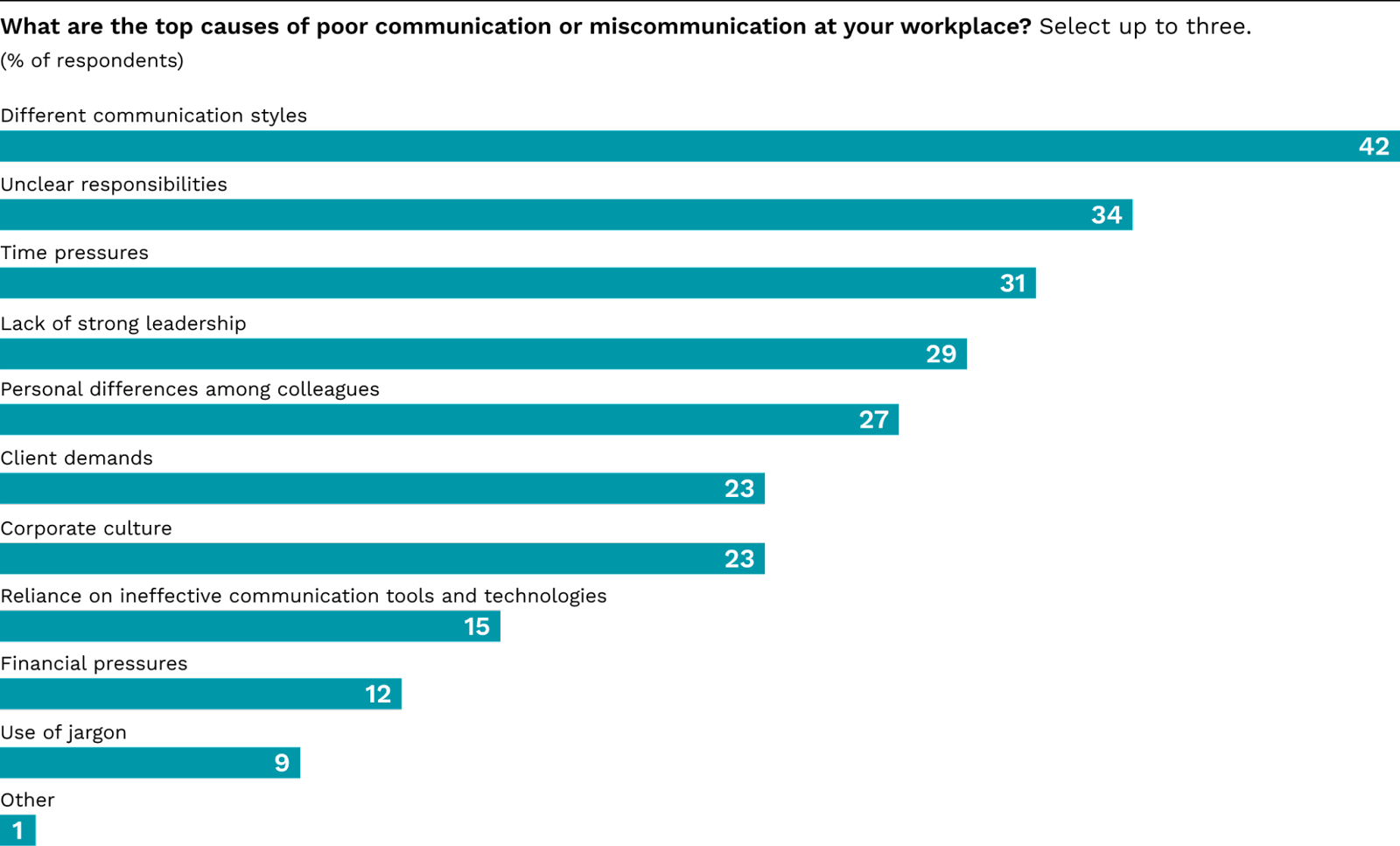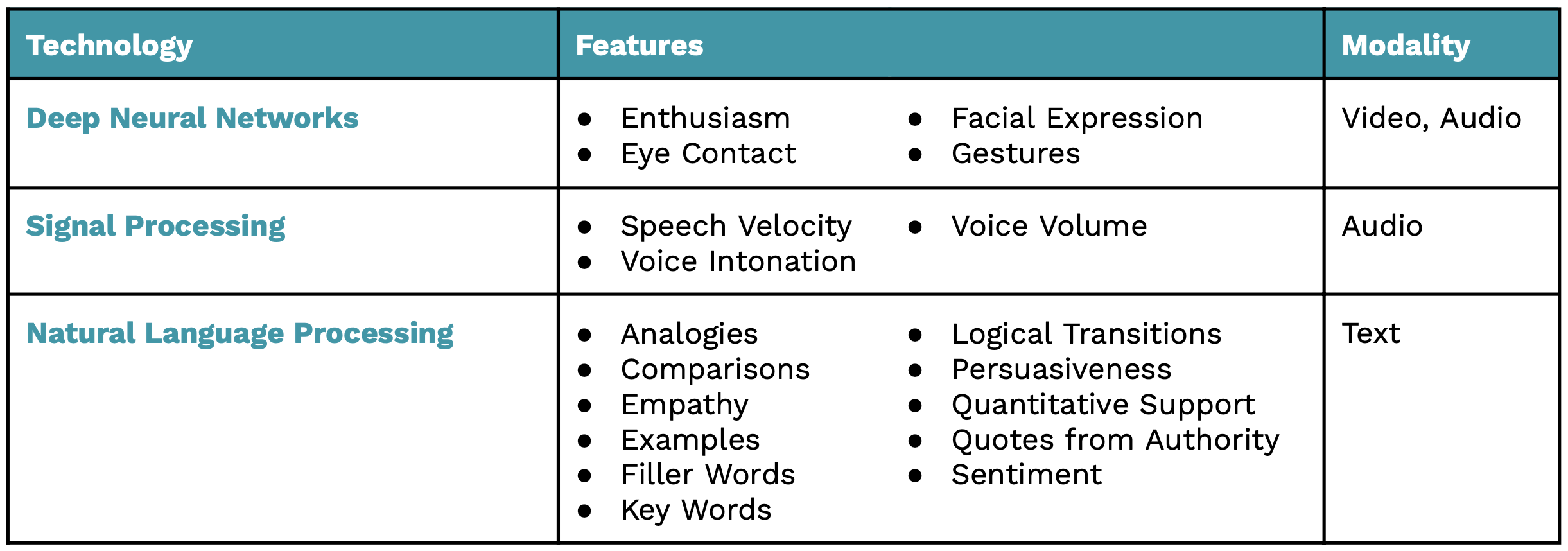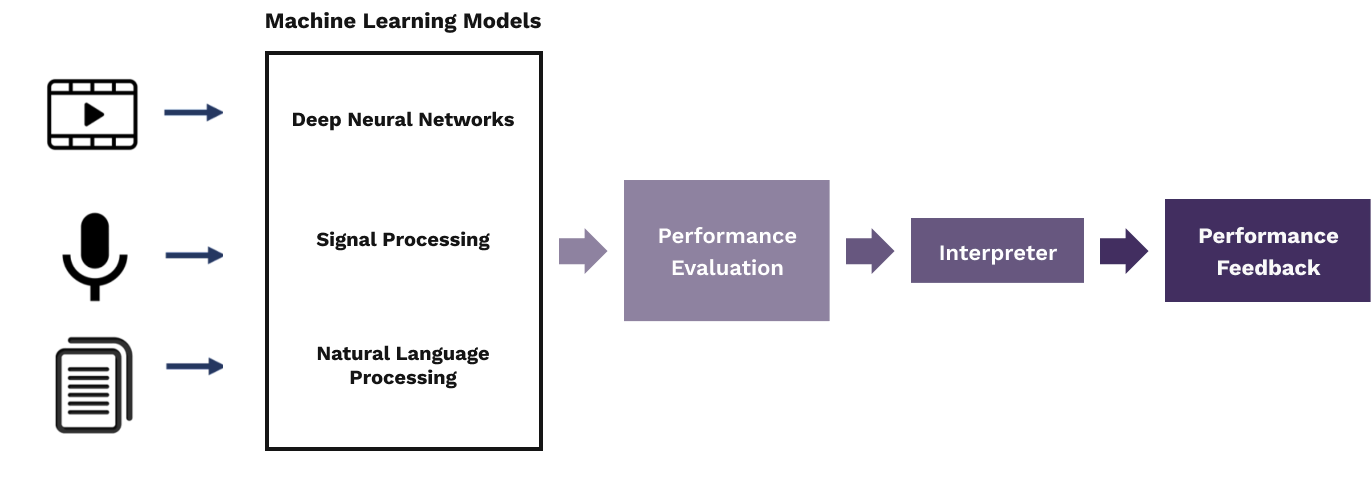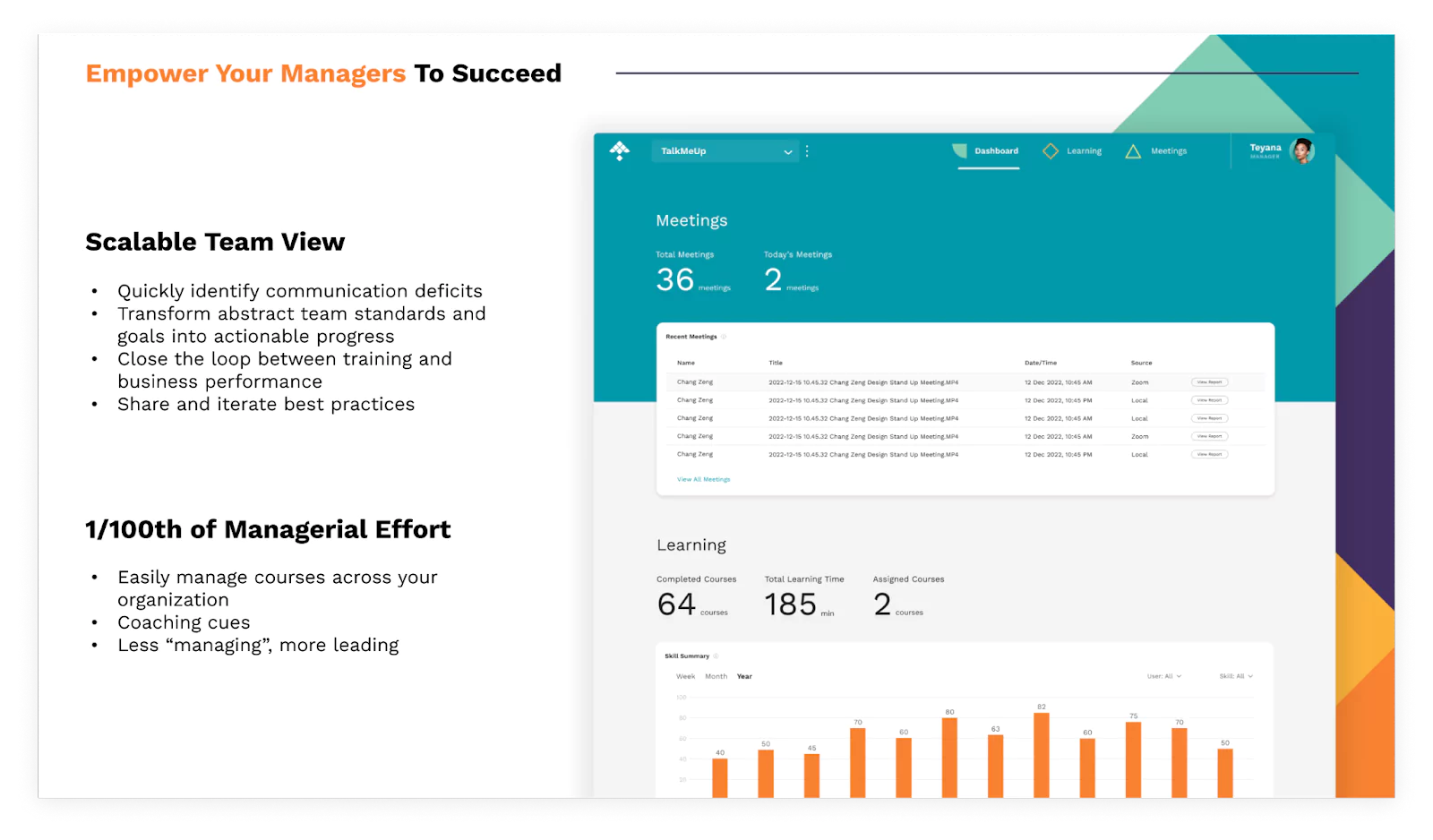The business world demands more effective communication—in person, in group settings, and on video calls.
Business success depends on how effectively we craft and deliver the right message in the right manner, aligned with the right audience. TalkMeUp elegantly addresses these business needs as clients realize gains in KPIs across the organization.
Introduction
Poor, ineffective communication negatively impacts companies through lost sales, customer retention, diminished employee engagement, and low productivity as shown in recent studies. The cost per employee is in the tens of thousands of dollars and across businesses into the millions. As a result, business executives are placing greater emphasis on effective communication more now than ever before.
Traditionally, only a few executives or high-potential employees would be candidates for communication effectiveness development and coaching due to the associated costs, time -required, and perceived return on investment.
TalkMeUp, Inc. has developed an innovative, one-of-a-kind software that addresses these needs and related shortcomings in profound ways. The company has automated the persuasive communication methodology and leverages AI for instant measurement, analysis, reporting, tracking, scaling, and more (see Figure 1).

As one of several points of validation, TalkMeUp won three Brandon Hall Group Gold awards for Excellence in Technology:
- Best Advance in Unique Learning Technology (Learning and Development)
- Best Advance in Sales Enablement and Performance Tools
- Best Advance in AI for Business Impact (Future of Work)
This paper describes why the award-winning TalkMeUp software is needed in business today; the costs, challenges, and risks facing companies due to poor, ineffective communication; the shortcomings of typical communication training methods; and how TalkMeUp overcomes those limitations and makes effective communication practice and development possible—for the masses. As evidence, use cases are presented to illustrate the platform’s impact in different settings.
What Is Communication Effectiveness?
Communication effectiveness is the process of artfully blending text as well as verbal and nonverbal elements to deliver a message with clarity and purpose. In business, effective communication is meant to persuade, inform, praise, realign, and much more—both internally and externally.
Communicators can draw their audience in with skillful delivery, charm, and pace, to deliver a compelling and persuasive message. But they can just as easily distract their audience with poor communication. Delivering a message is far more involved and complex (see Figure 2) than most realize—especially when the speaker is not informed about their communication style and skills, and does not possess the awareness to adjust message elements to meet the needs and expectations of the audience.

Different audiences and situations call for different communication elements and skills. A leader should not use the same tone or delivery when recruiting a new hire versus when terminating an existing employee. A sales professional should vary their tone when signing a deal than when addressing a customer problem.
As such, it is essential that communicators properly align their message delivery with their intent or mission—using facial expressions, voice inflection, consistent eye contact, and gestures that support what they’re trying to accomplish.
Once exposed to communication effectiveness tools and coaching, people naturally become far more aware of how they are using their communication skills and make adjustments. As with any skill, developing one’s communication effectiveness requires time and effort to learn, practice, and receive coaching and then repeat the cycle as they continue to develop mastery.
“It’s not what you say, but how you say it.” - Albert Mehrabian, PhD
Ineffective Communication Costs Companies Big Money and Productivity
Researchers have quantified the cost of poor business communication (see Figure 3). Business leaders now see a direct correlation between successes (and failures) and communication effectiveness in their organizations.

Several factors contribute to the concern that companies and their employees are not communicating effectively as listed below.
Businesses are losing new sales and existing customers due to:
- Inconsistent message quality control
- Customer-facing employees who are untrained communicators
Poor leadership communication impacts productivity since:
- The mission is not clear or completely understood
- Poor communication by leaders affects perceptions about the company overall
Workforce productivity is significantly impacted by poor communication as:
- Incorrect assumptions lead to failures
- Failures create a culture of blame and politics
Poor Communication Risks New Sales and Existing Customers
Those in external-facing roles talk to prospects, customers, investors, media, partners, suppliers, and others multiple times daily. Each conversation with those audiences should have a clear purpose and business objective that can be progressed or lost depending on the communication approach applied. Yet far too often, business professionals fail to make a meaningful connection.
When their respective audiences hear and see someone speaking who appears unprepared (rambling, unfocused, using filler words), lacks conviction (neutral facial expressions or voice intonation), lacks confidence (they sound subservient), or they seem untrustworthy (rarely makes eye contact or steers the conversation off course), the outcomes can be underwhelming and even detrimental to the individuals involved and their organizations. (For more on how TalkMeUp addresses these deficiencies, see Figure 3 below.)
These communicators are likely to be upstaged by competitors and cause companies to lose sales, lose customers, or lose business momentum while putting short- and long-term relationships at risk.
The following articles discuss these topics in far more detail and shed light on areas of risk—and cost—for leaders if they fail to acknowledge and address the issue of poor, ineffective communication in their workplace:
- Sales: Nearly 33% of sales lost due to poor communication were valued $100k-$999k (Economist Intelligence Unit).
- Customer Service: 53% of customers said unclear communication was the reason for a bad experience (Tolero Solutions Survey).
Poor Communication Hinders Workforce Productivity
Internally, poor communication from leaders and managers to employees, as well as among employees, leads to lost productivity. Figure 4 lists several factors contribute to the issues as revealed in the Economist Intelligence Unit:

In many cases, leaders lack self-awareness of how others perceive them and fail to adjust their message and communication style accordingly. That comes with considerable risk.
According to a Grammarly/Harris study, “nearly 9 in 10 business leaders (89%) report experiencing an adverse impact of poor communication at work. For the first time, we’re able to put words to the direct financial costs and the indirect talent and operational costs of ineffective communication. And there are some surprises—the first being that the cost of ineffective communication could be as high as $1.2 trillion per year for U.S. businesses:

Based on business leaders estimating the loss of 7.47 hours of work per week due to poor communication and reporting an average salary of $66,967 for their teams.” [“The State of Business Communication,” Grammarly, page 29.]
According to Gallup’s State of the Global Workplace: 2022 Report, disengaged employees cost the world’s businesses $7.8 trillion in lost productivity. In contrast, recent research shows that engaged employees are 17% more productive than their peers.
“According to new research of more than 600 US businesses with 50-500 employees, 63.3% of companies say retaining employees is actually harder than hiring them.” (Research: Employee Retention a Bigger Problem Than Hiring for Small Business)
Effective communication increases employee retention by 4.5 times, compared to businesses that lack effective communication in the workplace. Moreover, according to the Achievers’ report, 52% of employees say they stay in a job because they feel valued and supported.
The Micro Problem—The Limitations of Existing Practices
Virtually every job description demands that applicants possess “exemplary” or “exceptional” communication skills. But once hired, organizations are not equipped to help the new employees assess, practice, or master their ability to communicate effectively. It’s a skill you’re expected to bring with you and learn by doing.
When companies do invest in communication effectiveness training, they typically reserve the opportunity for a narrow group of executive leaders and high-potential employees. The primary reason companies exclude the majority of their workforce is return on investment due to the extremely high cost of traditional communication effectiveness training and development—in hard and soft dollars:
- cost of the training sessions—executive private coaching begins at $300/hour, classroom training starts at $1,200/pp, online courses range from hundreds to low thousands,
- scheduling,
- lost productivity,
- cost for hotel and air travel,
- inconsistent and inaccurate feedback from trainers and coaches,
- lag between training event and when feedback is eventually delivered at a later date,
- inability to focus on the specific needs of each individual, and
- event-based training sessions are one-and-done with no ongoing reinforcement.
Other challenges with traditional communication effectiveness training and coaching are the fear and discomfort of practicing in front of others—their peers or even their boss. Other critical risks with traditional methods are lack of immediacy and potential for bias. Evaluating each sample presentation takes considerable time. Thirty participants submitting practice presentations of five minutes each takes hours to sift through.
Video practice products have enabled employees to practice their message delivery by recording themselves and then socializing their videos for review by leaders, trainers, coaches, or peers—who in turn have to manually watch the videos, score them for message quality, delivery effectiveness, and message impact. Inherent in this laborious process are the inevitable concerns of:
- human error and implicit biases in scoring,
- inconsistent formats and depth of feedback and coaching,
- time delays in receiving feedback and coaching, and
- lack of ongoing reinforcement.
When asked what to do about workplace miscommunication, “... six out of ten respondents say firm-wide training (62%) and having a wider range of communication tools to use (63%) would significantly improve work communication. By improving in areas such as these, as well as being aware of communication differences and the best applications of various tools, the workforce can both communicate more effectively and keep pace with the inevitable continuous change in when and how we connect at work.” [“Communication barriers in the modern workplace,” The Economist Intelligence Unit, March 26, 2018, page 8.]
“We do not see things as they are; we see things as we are.” -Anonymous
What Is TalkMeUp? An Enterprise Solution for Communication Effectiveness
The TalkMeUp software is a patented, proven video practice and coaching platform that leverages artificial intelligence (AI) and machine learning (ML) to provide comprehensive analyses of communication style and skill. This breakthrough solution enables anyone to practice, develop, and hone communication effectiveness as they prepare to present and interact in a variety of situations.
How TalkMeUp Works
The TalkMeUp software analyzes how effectively an individual communicates and then helps them learn how to blend the three primary elements of communication (text as well as verbal and nonverbal communication skills) to deliver a message that is in line with their audience.
Using readily available camera technology that exists in computers and mobile devices, the platform enables learners to record and/or upload video that is analyzed according to communication effectiveness best practices. TalkMeUp evaluates the key communication elements and generates a user-specific report that instantaneously describes their performance.
To do this TalkMeUp actively tracks and measures the following metrics:

A learner-specific feedback report is generated and stored every time a person records or uploads a video. TalkMeUp references and compares the user/learner’s performance against a data lake of millions of benchmark data points from people all over the world.
Learners have access to and can compare their latest practice sessions against past performance, and track system usage and their level of communication effectiveness mastery via the Learner's Dashboard.
Artificial Intelligence/Machine Learning
Communication is multimodal as people share information not only through words, but also through voice prosody (the patterns of stress and intonation in language) and facial expressions. TalkMeUp’s AI system was designed to evaluate all of these elements that are key to communicating by extracting and processing information from video, speech, and text just as a human coach/audience would do.
Different modalities require different machine learning models. Figure 6 depicts a snapshot of the list of AI technologies used in TalkMeUp:

As shown in Figure 7, TalkMeUp employs a combination of different machine learning techniques such as deep neural networks, computer vision, natural language processing, signal processing, and statistical machine learning. We train specific machine learning models for each feature to achieve the level of accuracy needed. The outputs of each model are then fed into an interpreter module which transforms the numerical results into text-based feedback for users. The interpreter module is customizable to our users needs and standards.

Neurodiversity, Inclusion, and Avoiding Biases
Neurodiversity as defined by Harvard Health is “the idea that people experience and interact with the world around them in many different ways; there is no one ‘right’ way of thinking, learning, and behaving, and differences are not viewed as deficits.” TalkMeUp is sensitive to avoiding any potential biases and fostering inclusivity by all users.
TalkMeUp benchmarks all users against publicly available and internally developed datasets that contain the foundation for scoring and reporting on communication skills performance. This unique repository consists of more than 58.6 million data points that have been collected globally to recognize a variety of communication elements (e.g., facial features and speech characteristics) that provide benchmarks against which TalkMeUp evaluates each performance. The magnitude and vast diversity of multicultural inputs ensures that TalkMeUp properly evaluates and reports on communication effectiveness of users/learners regardless of geographic, demographic, or cultural boundaries.
Key Product Features and Capabilities
Multiple Input Modes
TalkMeUp processes audio and video files that are generated or uploaded in different ways, including:
- In-Workflow Analysis—TalkMeUp enables in-workflow processing and analysis of communication effectiveness. The system enables passive recording of video calls for analysis. This gives speakers an opportunity to view their communication effectiveness in real-world situations.
- In-Course Recording—Every TalkMeUp course ends with an opportunity for learners to practice the material they just learned.
- Freestyle—Learners are able to practice the delivery of their message in a safe, private, risk-free manner using the “Freestyle” recording feature. Access to the resulting performance report and recorded video remain private and available exclusively to the learner.
- File Uploads—Learners can upload files from virtually any source that can be analyzed by the systems.
Audience Engagement Analysis
TalkMeUp’s Multi-Person Analysis feature allows for the analysis of audio and video input of all participants on a call and produces a detailed report on the engagement and participation of each audience member, as well as the speaker’s performance (see Figure 8). This can be used in several ways, including challenge-and-response roleplays.

AI Report
Every time a learner records an AI Report is generated. The report includes:
- a performance summary for each communication metric;
- coaching that provides insights on how to achieve mastery;
- “What Good Looks Like,” which provides details on what the learner should be striving for, depending on the type of communication/message;
- the conversation transcript;
- the source video; and
- additional information that provides insights and assistance.
Learner’s Dashboard
TalkMeUp’s Learner’s Dashboard provides current and historical performance data that can be used to determine progress, and provides access to the course library.
Courses (Learning and Reinforcement)
TalkMeUp features a Course Library that contains:
- courses on each of the key communication attributes,
- personal and professional growth courses, and
- practice scenarios.
In addition to the standard Communication Effectiveness report, the learner’s performance is evaluated and scored based on the course-defined situation and content. The content provides a comprehensive learning source that can be used and applied over a span of 52 weeks that collectively establishes a communication effectiveness mastery program.
Management and Administrative Oversight
Manager Dashboard
TalkMeUp’s administrative dashboard provides leaders, coaches, and trainers with a view of their learners’ performance (see Figure 9). This can be viewed according to the organization's hierarchical structure, by cohorts, and by individual learners.

The administrative dashboard offers key functionality, including:
- viewing of data by organizational hierarchy,
- viewing of historical performance,
- assigning courses,
- providing feedback to learners about their individual performance, and
- registering and inviting new learners.
Managers and trainers are able to view the learner’s communication effectiveness strengths, weaknesses, overall progress, time spent in the system, progress on courses, and a variety of other information required to monitor progress and use by team or individual. The scalability—combined with these insights—empowers them to be more effective and impactful coaches than ever before.
Enterprise Scalability
The TalkMeUp platform was designed to be infinitely scalable and manages this in two ways. First, the system was developed using typical SaaS architecture methods and techniques such that computing and storage capacity is added as needed without service interruptions.
The second method of scaling is operational and accomplished through automation. Coaches, trainers, and leaders can rely on performance data generated and reported by the system to determine whether or not a particular learner, or group of learners, need assistance—eliminating many hours of video viewing and scoring. The automated operations include:
- analyzing and scoring videos,
- delivering comprehensive analyses instantaneously,
- automatically reporting performance feedback and coaching, and
- providing a dashboard view of individual and team performance.
System Requirements
TalkMeUp requires no installation effort from IT or the learner. The following are all that’s needed to use the system:
- browser,
- camera and microphone (found on virtually every mobile device, laptop, computer),
- learner name and email address, and
- team/cohort relationship.
Accessibility
The stated mission of TalkMeUp is to empower every person and every organization all over the world to communicate their message effectively. As such, the company strives to ensure that anyone—regardless of gender, age, race, ethnicity, or any other demographic attribute as well as their position or abilities—is able to use and benefit from the platform.
TalkMeUp adheres to the standards set in Web Content Accessibility Guidelines (WCAG) 2.1. The system is regularly evaluated against new WCAG updates to ensure compliance.
Security and Privacy
TalkMeUp is a SaaS-based system that is hosted by Amazon Web Services (AWS). As such, all data and system components are protected by AWS security architecture using globally accepted standards. Additionally, TalkMeUp is SOC I and SOC II compliant. This approach has enabled the platform to pass stringent security screening in complex, heavily regulated environments such as those in financial institutions.
TalkMeUp, Inc.’s employees do not have access to customer video content. Individual user video files can be purged upon request. TalkMeUp has a comprehensive, documented security and privacy policy that is available upon request.
Integration
TalkMeUp easily integrates with a variety of CRM, LMS, and HRIS systems to allow quick, easy, and safe access by learners. The system offers an open API, SCORM, and Single Sign-On (SSO) to ensure ease of access and use.
Customization and Tailoring
TalkMeUp is ready to use from the start of an engagement. However, various elements of TalkMeUp—from AI to course content—can be tailored to meet an organization’s specific needs, for example:
- communication elements such as Persuasiveness can be added or hidden as desired;
- the scoring and feedback of AI metrics can be adjusted towards different standards and learning goals;
- the AI can be calibrated to custom-developed courses to ensure learners are being measured accurately and consistently; and
- communication elements can be custom-developed and trained according to customer specifications.
TalkMeUp Use Cases and Proof Points
Validation: TalkMeUp vs. Classroom Environments
TalkMeUp’s effectiveness was validated in a study that evaluated it with traditional communication training and coaching methods. Its value and efficacy was proven in a variety of business settings.
The validation study objectives were to compare the use of TalkMeUp and MBA classroom communications training methods and measure short- and long-term results as well as retention and the learner experience.
Fifty Carnegie Mellon University MBA Program fellows with diverse backgrounds and work experience were divided into two test groups. The study was divided into four phases (Benchmark, Training, Pause, and Application) and spanned the spring semester, paused for the summer break, and concluded in the fall.
A control group of 25 fellows followed a traditional classroom-based method of developing communication effectiveness and presentation skills. They attended two classes per week taught by a tenured communication professor and expert. Fellows were required to present in class. The professor provided live feedback, but the presentations were also recorded on video to be reviewed by TAs who reviewed recordings, documented feedback, and sent them to the fellows.
A second group of 25 fellows were given access to TalkMeUp, shown a short demo, and were instructed to use TalkMeUp as often or little as they wished.
The results were clear: TalkMeUp users demonstrated 5x better results in both short- and long-term skill improvement. They also reported 3x better learning experience regarding remote, self-paced, and real-time feedback.
Neurodiversity Study Results
A study was conducted involving 70 students with confirmed educational disabilities at the Agora Cyber School. The intended goal was to stimulate communication effectiveness growth. Students used the native TalkMeUp program without any special modifications or customization.
The results were reassuringly positive: After one month of practice, users’ performance increased by 20%. The social impact among the users was even more significant as educators and administrators observed heightened levels of engagement and increased confidence in communicating with each other in class.
Client Use Cases
With this confirmation and validation, the TalkMeUp team continued to refine and advance the platform. In the years since launching the platform, TalkMeUp has been used in a variety of environments across industries and roles.
One client incorporated the use of TalkMeUp as part of its emerging leaders program. They recognized the importance of effective communication as business leaders responsible for communicating up to senior management, down and across the organization, and representing the business with external constituents. After 12 sessions of practicing for five minutes, the high-potentials realized a 30% overall team improvement and up to a 78% individual improvement among users.
Another client was experiencing an unacceptable churn rate that necessitated immediate action. A comprehensive analysis (including listening in on client calls) revealed the client success team was not executing their established messaging. The executive team began using TalkMeUp intending to track and measure CSR progress and performance. They established training around best practices and made TalkMeUp the center of the remediation process. TalkMeUp built tailored curriculums for the CS team to learn and develop new skills. In addition to increasing winbacks by 30%, upsell revenue increased 135%, and sales referrals increased 35%.
These instances and others revealed not only the efficacy of applying TalkMeUp, but also the ease with which it can be implemented and expanded to include additional users.
Operating successfully with strong sales numbers and high productivity rates often hinge upon the relationships established by the people responsible for those functions and processes. Organizations have a wide range of roles that contribute to that success, as there are numerous areas where TalkMeUp can be applied.
About TalkMeUp
TalkMeUp’s key customers include Hearst Corporation, Disney/ESPN, Fitch, BTS, and Riskalyze.
TalkMeUp is a proven video practice and coaching platform that leverages AI to provide comprehensive analyses of communication style and skill. It enables business professionals to ensure communication effectiveness as they prepare to present in a variety of situations.
Learners record, practice, and receive instant feedback on fundamental and strategic messaging that ensures communicators achieve their desired outcomes. Anyone with a cellphone or laptop camera can record themselves 24x7x365, free of judgment and consequence.
TalkMeUp’s AI saves countless hours that managers, trainers, and coaches spend reviewing and scoring practice videos and delivering feedback. The AI provides immediate detailed, accurate, consistent user-specific feedback and eliminates time constraints and potential biases that a live coach may introduce into the review, scoring, and coaching processes.
About the Authors
Ronald J. Placone: PhD in Rhetoric, Associate Teaching Professor, Management Communication, Carnegie Mellon Tepper School of Business
David Solot: PhD in Industrial/Organizational Psychology, Chief Scientist & Head of Product, Sciolytix
Albert Topdjian: Chief Product Officer, TalkMeUp
Jeff Meyers: Marketing & Communications Consultant



